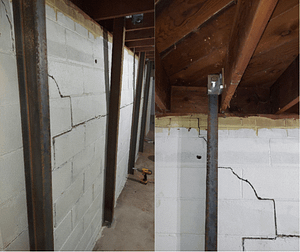Best Basement Waterproofing - Truths
Best Basement Waterproofing - Truths
Blog Article
Little Known Facts About Best Basement Waterproofing.
Table of ContentsThe Buzz on Best Basement WaterproofingThe Basic Principles Of Best Basement Waterproofing Everything about Best Basement WaterproofingThe Buzz on Best Basement WaterproofingThe smart Trick of Best Basement Waterproofing That Nobody is Discussing
uses excavation strategies toward all-time low of the framework's structure. involves getting rid of moisture after it has gone into the cellar. AdvantaClean's experienced specialists and technicians will find the water resource. If wall surface or piece cracks exist, we will inject polyurethane and epoxies right into the fractures and secure the concession, avoiding additional wetness from getting in.If there's condensation on the outside of the aluminum foil, you have high humidity in your basement. If the aluminum foil has condensation on the within surface (following to the wall), the dirt around your house might be normally damp from a high water table or bad soil drain.
You can waterproof just your indoor walls, which might resolve the issue. Once they dry out, they stick permanently to concrete and stonework walls.
Unknown Facts About Best Basement Waterproofing
Concrete water-proof coatings can't be used to formerly repainted surface areas; inspect the label. Known as densifiers, they are suitable just for wall surfaces that have not been repainted or sealed.
You clean, roll, or spray it on much even more heavily one gallon covers simply 75 square feet, not the 300 square feet regular with basic paint. Water resistant paint is fine for DIY application. You can use it over repainted surfaces, and paint over it once it's healed (one gallon expenses $37).
It can set you back $10,000 to $15,000, depending on the work required. Exterior waterproofing involves digging deep into all around the house to the complete deepness of the structure walls, after that mounting a waterproof coating or membrane layer topped by water drainage panels.
A cellar without waterproofing is kind of like that. Your basement doesn't want to go via a downpour without proper security simply as much as you do not want to.
Some Known Facts About Best Basement Waterproofing.
However if you have actually done your study, you would certainly recognize there are two kinds of waterproofing: interior and outside. It can obtain puzzling what they both mean, which one's a much better investment, and what will actually maintain the water out. Don't worry, we created this blog to conveniently define both methods for you and talk about the advantages and disadvantages of each.
Exterior waterproofing is a waterproofing method that involves sealing your home from the exterior. It's kind of like a moat around a castle. It includes excavating a trench around your entire house to the structure (regarding 8 to 10 feet down). The foundation wall surfaces are after that cleansed, secured, and covered visit their website with a water resistant membrane or sealer.

9 Easy Facts About Best Basement Waterproofing Shown
It's an extra involved process that calls for digging up your yard, which is pricey and taxing. Outside waterproofing includes removing everything surrounding the home, including verandas, driveways, pathways, landscape design, air conditioner units, decks, and more. If any one of the job was done incorrectly and water is still entering your basement, there isn't much you can do to remedy or repair it.
Inside cellar waterproofing involves waterproofing from the inside. Any kind of water that leakages right into your cellar is rerouted prior to it touches your flooring. It's sort of like putting on a raincoat under your clothes. It involves two things: a water drainage track and a sump pump. It works by sealing the inside of your basement walls and floors so water that attempts to enter is transported out via a sump pump.
It's an effective technique to water resistant your cellar. The drawback of indoor basement waterproofing mainly has to do with the setup process.
The Single Strategy To Use For Best Basement Waterproofing
Finally, outside and indoor basement waterproofing are both effective techniques of safeguarding your home from water damage. Exterior waterproofing produces a barrier that stops water from entering your home, while indoor waterproofing redirects water that does enter your home. And it's important to note that outside waterproofing is an expensive link and turbulent installation process when contrasted to interior waterproofing.
Whichever approach you pick, ensure read the article you pick a reputable and credible contractor for the work. Both techniques require seasoned workers to handle the work. If you have any questions regarding basement waterproofing, please get to out to us. And if you remain in our service location and have water in your basement, call us for a complimentary, no-obligation home inspection.
You can complete our form below, start a conversation in the lower right-hand corner, or call us at 1-800-827-0702.
Report this page